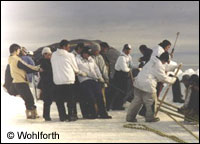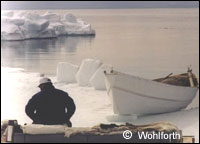Out on the ice that forms the shores of the Arctic Ocean, the Iñupiaq whalers of Barrow, Alaska, hauled in their catch, a bowhead whale that weighed more than 100,000 pounds. The entire village turned out to pull the enormous mammal ashore and butcher it. Sleds and snowmobiles were piled with maktak (energy-laden slabs of whale blubber and skin) and fresh bloody meat.
The hunt had been difficult. The temperature rose above freezing, the ice cracked, and the seas grew rough, forcing the whaling crews to retreat inland more than once. When the whale was finally landed on the evening of May 10, 2002, it was raining in Barrow. The rain washed away the snow — the earliest snowmelt ever recorded in Barrow. That “wet thaw of the terrible spring whaling season of 2002” marked the moment, writes long-time Alaska resident and journalist Charles Wohlforth, when “Barrow’s Iñupiaq leaders accepted that climate change was real and one-way.”
In The Whale and the Supercomputer, Wohlforth tells the story of “climate change in the flesh” — what life is like for Arctic Natives who now live on the front lines of global warming. The book sets up a kind of counterpoint between Natives’ experiences and those of climate scientists at universities and research institutions around the world. Just as most Iñupiaq are unfamiliar with computer models of climate change, these scientists generally have no personal knowledge of how thawing permafrost can ruin a hunting party’s cache of frozen caribou or how cracking ice can set a group of families adrift.
To tell his story, Wohlforth tags along with Barrow’s whaling crews, talks to Iñupiaq elders, spends time with the community’s extended families, accompanies climate scientists on a 1,000-mile Arctic sampling trip, and interviews numerous deskbound assessors of the planet’s climate. The dance between hard science, with its peer-reviewed data and high-tech number crunching, and Natives’ knowledge of natural history gained through long years of patient observation forms the heart of Wohlforth’s narrative.
In one section, he describes two climate scientists on a trip to the Arctic “looking for numbers a computer could understand — the height of an ice chunk, the temperature of a layer, the size of a grain.” What the scientists’ 74-year-old Iñupiaq consultant and guide had to say “was almost irrelevant.” And yet the guide’s “understanding of the ice in all its dimensions, from the atmosphere to the sea floor, ocean currents, and development through time, was the view the scientists were ultimately after, but they would approach it only years and millions of dollars from now.”
In his desire to embrace both sides of this cognitive divide, Wohlforth has written a descriptive rather than a prescriptive book. While the final chapter includes some scientists’ suggestions for shifting energy sources in order to curtail the carbon dioxide emissions that contribute to global warming, the book’s primary focus remains the philosophical and cultural differences between the Iñupiaq and the mainstream scientific community. Wohlforth refrains from offering any solutions himself. Instead, he reflects on what he’s learned from the Iñupiaq about adaptability, survival, and change.
“Traditional knowledge to me is centuries of trial and error. … Survival is built around respect. You think you’re better than the weather? Let’s see what the weather has got in store for you,” an Iñupiaq geologist and whaler told Wohlforth. Now, says Wohlforth, “the weather was changing for everyone, and there was a sense, in what some elders said, that a lack of respect was indeed the reason.”
The Whale and the Supercomputer is a thoughtful book. It uses the Iñupiaq experience to highlight some basic flaws in our consumption-crazy, technology-loving industrialized world. Yet the book would have been stronger if Wohlforth had gone out on a limb and waxed practical as well as ruminative.
“The question remained how the world would react once understanding [of the impact of climate change] was widespread,” writes Wohlforth. “Humankind has never faced a similar choice. The lessons of evolution and ecology — all prior experience on Earth — tell us nothing about an entire species giving up its cheapest and most abundant supply of energy for the benefit of unknown individuals living generations in the future.”
Elegantly put and true, but what do we do now?





